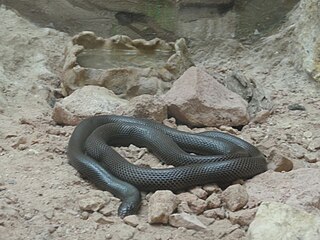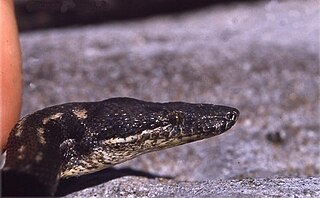This page is based on this
Wikipedia article Text is available under the
CC BY-SA 4.0 license; additional terms may apply.
Images, videos and audio are available under their respective licenses.
The Anomochilidae, or anomochilids, are a monotypic family of snakes, created for the genus Anomochilus, which currently contains three species.

The Acrochordidae, commonly known as wart snakes, Java wart snakes, file snakes, elephant trunk snakes, or dogface snakes, are a monogeneric family created for the genus Acrochordus. This is a group of primitive aquatic snakes found in Australia and tropical Asia. Currently, 3 species are recognized.

The Typhlopidae are a family of blind snakes. They are found mostly in the tropical regions of Africa, Asia, the Americas, and all mainland Australia and various islands. The rostral scale overhangs the mouth to form a shovel-like burrowing structure. They live underground in burrows, and since they have no use for vision, their eyes are mostly vestigial. They have light-detecting black eye spots, and teeth occur in the upper jaw. The tail ends with a horn-like scale. Most of these species are oviparous. Currently, 18 genera are recognized containing over 200 species.

The Atractaspidinae are a family of snakes found in Africa and the Middle East, commonly called mole vipers, stiletto snakes, or burrowing asps. Currently, 12 genera are recognized.

Gloydius is a genus of venomous pitvipers endemic to Asia, also known as Asian moccasins or Asian ground pit vipers. Named after American herpetologist Howard K. Gloyd, this genus is very similar to the North American genus Agkistrodon. 17 species are currently recognized.

The Aniliidae are a monotypic family created for the monotypic genus Anilius that contains the single species A. scytale. Common names include American pipe snake and false coral snake. It is found in South America. This snake possesses a vestigial pelvic girdle that is visible as a pair of cloacal spurs. It is ovoviviparous. It is non-venomous, and its diet consists mainly of amphibians and other reptiles. Currently, two subspecies are recognized, including the typical form described here.

The Bolyeriidae are a family of snakes native to Mauritius and a few islands around it, especially Round Island. They also used to be found on the island of Mauritius, but were extirpated there due to human influence and foraging pigs in particular. These snakes used to be placed in the Boidae, but are now classed as a separate family. Two monotypic genera are recognized, but only a single species is extant. Bolyeriidae appear to be most closely related to the Asian genus Xenophidion.
The Uropeltidae, the shieldtail or shield-tailed snakes, are a family of primitive, nonvenomous, burrowing snakes endemic to peninsular India and Sri Lanka. The name is derived from the Greek words ura ("tail") and pelte ("shield"), indicating the presence of the large keratinous shield at the tip of the tail. Seven or eight genera are recognized, depending on whether Teretrurus rhodogaster is treated in its own genus or as part of Brachyophidium. The family comprises over 50 species. These snakes are not well known in terms of their diversity, biology, and natural history.
Brongersma's worm snake is a harmless blind snake species endemic to South America. No subspecies are currently recognized.
The Sindh thread snake is a species of harmless blind snake in the family Leptotyphlopidae. The species is endemic to India and the Middle East.

Myriopholis macrorhyncha, also known as the long-nosed worm snake or hook-snouted worm snake is a harmless blind snake species found in northern Africa and southwestern Asia. No subspecies are currently recognized.
Argyrophis diardii, known commonly as Diard's blind snake, the Indochinese blind snake, the large blind snake, or the large worm snake, is a species of harmless snake in the family Typhlopidae. The species is endemic to South Asia and Southeast Asia. There are two recognized subspecies.
Jerdon's worm snake is a species of harmless blind snake in the family Typhlopidae. The species is endemic to India. There are no subspecies which are recognized as being valid.
Argyrophis oatesii, also known as the Andaman Island worm snake or Oates's blind snake, is a harmless blind snake species found in the Cocos Islands. No subspecies are currently recognized.
The South India worm snake is a harmless blind snake species found in southern India. No subspecies are currently recognized.
The slender worm snake is a species of harmless blind snake in the family Typhlopidae. The species is endemic to South Asia. There are no subspecies that are recognized as being valid.
The Samagutin worm snake is a harmless blind snake species found in northern India. No subspecies are currently recognized.
Typhlina is a taxonomic synonym that may refer to:
Typhlops russellii is a taxonomic synonym that may refer to:
The coffee worm snake is a harmless blind snake species found in Mexico and Guatemala. No subspecies are currently recognized.







